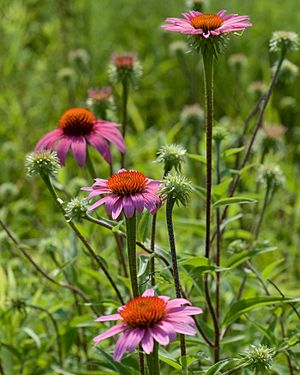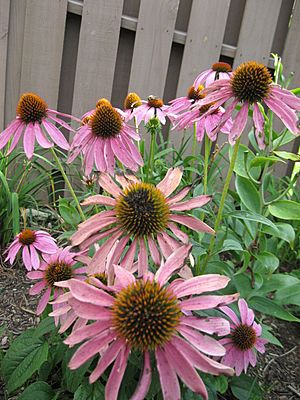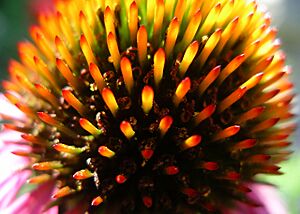Eastern purple coneflower facts for kids
Quick facts for kids Eastern purple coneflower |
|
|---|---|
 |
|
| At a prairie preserve in southwest Arkansas | |
| Scientific classification | |
| Genus: |
Echinacea
|
| Species: |
purpurea
|
| Synonyms | |
|
|
The Echinacea purpurea is a beautiful flowering plant often called the eastern purple coneflower or simply purple coneflower. It's also known as hedgehog coneflower or just echinacea. This plant belongs to the sunflower family and grows naturally in North America.
You can find it growing wild in many parts of the eastern, southeastern, and midwestern United States. It also grows in the Canadian Province of Ontario. It likes dry, open woods, prairies, and open fields.
Contents
What's in a Name?
The name Echinacea comes from the Greek word for 'spiny one'. This is because the ripe flower heads look a bit like spiny sea urchins. The second part of its name, purpurea, means 'reddish-purple'. This describes the color of its flowers.
A famous scientist named Carl Linnaeus first named this plant Rudbeckia purpurea in 1753. Later, in 1794, another scientist, Conrad Moench, gave it its current name, Echinacea purpurea.
What Does It Look Like?
The purple coneflower is a type of herbaceous perennial plant. This means it has soft stems (not woody like a tree) and comes back year after year. It can grow up to about 120 centimeters (nearly 4 feet) tall and 25 centimeters (about 10 inches) wide.
It usually blooms from summer into autumn, depending on the weather. Its flowers are shaped like cones and are often purple, though not always. Each flower head is actually made up of many tiny individual flowers, called florets. These florets are hermaphroditic, meaning each one has both male and female parts.
Butterflies and bees love to visit these flowers, helping to pollinate them. The plant has leaves that are oval or lance-shaped, and they can be quite large. The main flower head is usually 7 to 15 centimeters (about 3 to 6 inches) across. It has a raised center made of small yellow florets, surrounded by pink or purple petals (which are actually special florets too).
This plant grows best in sunny spots with soil that drains well. After the flowers fade, they produce small fruits called achenes, which birds enjoy eating.
Growing Purple Coneflowers
Many people grow Echinacea purpurea in their gardens because it's a beautiful ornamental plant. It's perfect for flower beds, along walkways, or as part of a border. You can also cut the flowers to make lovely fresh bouquets for inside your home.
Gardeners have created many different types of purple coneflowers, called cultivars, which have special flower colors or plant shapes. This plant can grow in full sun or light shade. It can handle both dry and moist soil, and once it's settled, it can even survive periods of drought. Some popular types, like 'Ruby Giant', have even won awards for being great garden plants.
How to Grow New Plants
You can grow new purple coneflower plants in a few ways:
- Dividing plants: You can split a large plant into smaller pieces, usually in spring or autumn.
- Root cuttings: You can take pieces of the roots and plant them.
- Seeds: You can also grow them from seeds. Seeds grow best when they experience changes in daily temperature. You can start seeds indoors before the warm season or plant them directly outside once the weather is warm enough.
Who Eats Echinacea?
When purple coneflower plants are young, or just starting to grow in spring, Slugs and rabbits sometimes like to eat their leaves. Also, gophers can sometimes damage and eat the roots.
Echinacea and Medicine
For a very long time, Native Americans used the purple coneflower as a medicine. They used it to help with many problems, like wounds, burns, insect bites, toothaches, and even snake bites.
Today, scientists are still studying Echinacea purpurea. Research suggests it might help support the immune system. This has led to new interest in using it to help people with certain health conditions or to support a healthy immune system during stressful times. It's one of the most widely grown plants for medicinal purposes.
Images for kids
See also
 In Spanish: Echinacea purpurea para niños
In Spanish: Echinacea purpurea para niños





